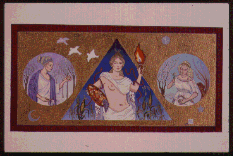Demeter And Kore (Persephone)
 Demeter, an ancient Greek Goddess of the cultivation of grain is best known for her fierce
defense of her daughter, Kore. Later known as Persephone, Kore, a beautiful young maiden was
playing in the fields on the Eleusis Plain and as she plucks a narcissus, the hand of Hades reaches
up from the underworld and kidnaps her. Demeter heard her daughter cry out, but could not find
her. Carrying a torch for nine days and nine nights, she searched for her daughter without stopping
to rest. On the tenth day Helios told her who had abducted Kore.
Demeter, an ancient Greek Goddess of the cultivation of grain is best known for her fierce
defense of her daughter, Kore. Later known as Persephone, Kore, a beautiful young maiden was
playing in the fields on the Eleusis Plain and as she plucks a narcissus, the hand of Hades reaches
up from the underworld and kidnaps her. Demeter heard her daughter cry out, but could not find
her. Carrying a torch for nine days and nine nights, she searched for her daughter without stopping
to rest. On the tenth day Helios told her who had abducted Kore.
Demeter took refuge in Eleusis and refused to return to Olympus until her daughter was returned. Because of her departure, the earth became sterile and famine threatened all mortals. Zeus, finally disturbed by this turn of events, commanded Hades to allow Kore to return to earth. However, because she had eaten of the pomegranate, which was a magical symbol of living with the dead, also often a symbol of the marriage bond, it was decided that Kore (now Persephone) would live with her mother two-thirds of the year and remain with Hades for one-third of the year.
Scene I: Kore, as a youthful maiden has just plucked the narcissus. It is early Spring when the earth has begun to flower. The hand of Hades reaches up from the fires of the Underworld.
Scene II: Demeter is shown carrying her torch symbolizing her eternal vigilance. She is often depicted with a serpent around each arm, holding three ears of corn. She is carrying the fruits of the harvest as a symbol of wealth and fertility and abundance of the earth. She is celebrated by the festivals of Thesmophoria and Eleusinia.
Scene III: Kore (meaning young maiden), now called Persephone holds the pomegranate, a symbol of her marriage to Hades; the poppy, a symbol of sleep for the living and the dead. The barren trees signify the period of time when Persephone is away from her mother -- winter.
Back